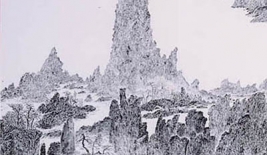
Wang Huaiqing 1944 -
Beijing.China
Click here to download full CV
Biography
Born in Beijing, 1944, Wang had a love of arts because of the influence of his elder brother, and entered the Central Academy of Arts and Crafts in 1964 to study interior design. In 1970, during the Cultural Revolution, Wang was assigned to the countryside for ‘rehabilitation through labor' where he learned painting under the tutelage of Wu Guan-Zhong. In 1980, Wang formed the Contemporary Painting Society with his fellow classmates, organized an exhibition at the National Arts Gallery and joined the National Chinese Artists Association. He received a master's degree a year later. Wang's work has been selected for exhibitions worldwide including the recent major exhibition at the Guggenheim Museum, New York, entitled “5000 Years of Chinese Art” and “Art Basel: Modern Art Exhibition” at the German Embassy in Beijing.
Since the 1980s, Wang's work has expressed his nostalgia for Chinese traditional cultures. The black tile and white wall traditional Jiangnan building that was mainly of a wooden structure gave him strong visual storming. The simplification of traditional residential estates resembled paper cuttings or silhouettes, was in between semi-concretization and semi-abstraction. Since the return from the United States in 1988, Wang shifted his focalization from the concern for Jiangnan's traditional residential estates further to ‘Ming-style furniture'. The style of his work became more refined and even more graceful and pure. He used “disassembling” as a device, daringly deconstructing Ming-style furniture and then reconstructing it. From those structural elements that had already been demolished, or even those with a diasporic visuality, both brought to people a sense of unnamable melancholy. Throughout, his work revealed a profound sense of cultural crisis which seemed to originate from the anxiety of the disconnection of culture and tradition.
Wang, as a Chinese painter, must not only confront a huge western world but also a great ‘tradition’. Wang Huaiqing proves that he has found his own point of entry between these two great pillars: structure. Traditional wooden buildings and furniture have given him boundless enlightenment and inspiration. From the hard, twisting qualities of wood, and transverse or vertical lines of mortise and tenon forms, the artist has come to feel the existence of the ancient culture which underlies a nation.
Wang's art, stylistically, is closer to the modern West, while in flavor it is purely Eastern. Deep and implicit with a quiet sense of non-exaggeration, his works evoke gentleness, grace and thoughtfulness with inner tension.
——Extract from
Jia Fangzhou, A World of Contrasts – on Wang Huaiqing's Modern Structure.
Chia Chi Jason Wong, Fracture & Reconstruction- About the Artistic Forms and Cultural Contents of Wang Huaiqing's.
Exhibitions

Derivations: Unlimited Crossing2013 │ 08.10 - 08.25
Lin & Lin Gallery

The Way Is Not Merely Between Two Points2010 │ 12.18 - 01.30
Lin & Lin Gallery

The Joint Exhibition of George Chann, Wang Huaiqing, Su Xiaobai2009 │ 11.14 - 12.06
Lin & Lin Gallery

Extending and Crossing Over to the New Future2009 │ 08.15 - 09.08
Lin & Lin Gallery

Double Happiness 2009 │ 01.11 - 02.11
Lin & Lin Gallery

In the Backyard II:Over-flowing Landscape of Desire 2001 │ 08.11 - 09.02
Lin & Lin Gallery

The Solo Exhibition of Wang Huaiqing1999 │ 01.02 - 01.18
Lin & Lin Gallery















